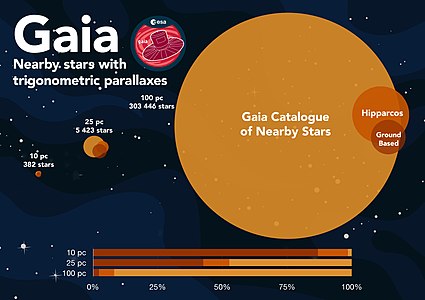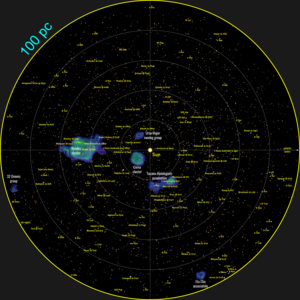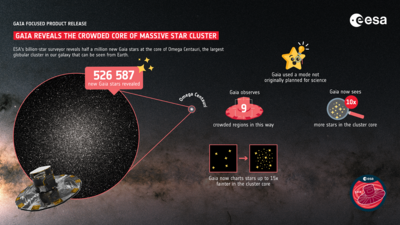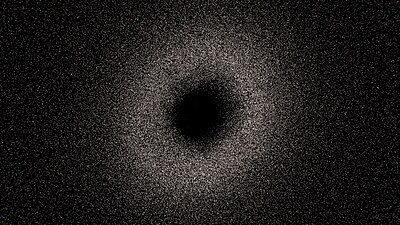
Gaia is a space observatory of the European Space Agency (ESA), launched in 2013 and expected to operate until 2025. The spacecraft is designed for astrometry: measuring the positions, distances and motions of stars with unprecedented precision, and the positions of exoplanets by measuring attributes about the stars they orbit such as their apparent magnitude and color. The mission aims to construct by far the largest and most precise 3D space catalog ever made, totalling approximately 1 billion astronomical objects, mainly stars, but also planets, comets, asteroids and quasars, among others.

21 Aquilae is a solitary variable star in the equatorial constellation of Aquila. It has the variable star designation V1288 Aql; 21 Aquilae is its Flamsteed designation. This object is visible to the naked eye as a dim, blue-white hued star with a baseline apparent visual magnitude of about 5.1. The star is located at a distance of around 680 light-years from Earth, give or take a 20 light-year margin of error. It is moving closer to the Earth with a heliocentric radial velocity of –5 km/s.

9 Aurigae is a star system in Auriga (constellation). It has an apparent magnitude of about 5, making it visible to the naked eye in many suburban skies. Parallax estimates made by the Hipparcos spacecraft put it at about 86 light-years from the solar system, although individual Gaia Data Release 3 parallaxes place all three components at 88 light years.
40 Boötis is a single star located 166.5 light years away from the Sun in the northern constellation of Boötes. It is visible to the naked eye as a dim, yellow-white hued star with an apparent visual magnitude of 5.64. The star is moving away from the Earth with a heliocentric radial velocity of +12 km/s.
N Centauri is a binary star in the southern constellation of Centaurus. The brighter star is dimly visible to the naked eye with an apparent visual magnitude of 5.26, and it is approximately 304 light years away based on parallax. It has an absolute magnitude of +0.76 and is drifting further away from the Sun with a radial velocity of +27 km/s. It is a candidate member of the Sco OB2 moving group.
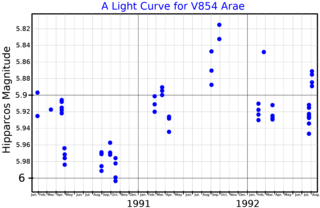
HD 155035 is the Henry Draper Catalogue designation for a star in the constellation Ara, the Altar. It is located at a distance of approximately 1,450 light-years from Earth and has an apparent visual magnitude of 5.92, making it is faintly visible to the naked eye. This is a red giant star with a stellar classification of M1.5 III. It an irregular variable that changes brightness over an amplitude range of 0.12 magnitudes.

HD 27245, also known as HR 1335 or rarely 25 H. Camelopardalis is a solitary red-hued star located in the northern circumpolar constellation Camelopardalis. It has an apparent magnitude of 5.4, making it faintly visible to the naked eye. Gaia DR3 Parallax measurements place it approximately 607 light years away from it the Solar System and is drifting further away with a heliocentric radial velocity of 25.2 km/s. At its current distance, HD 27245's brightness is diminished by 0.36 magnitudes due to extinction from interstellar dust. It has an absolute magnitude of −0.27.
74 Cygni is a visual binary star system in the northern constellation Cygnus, located around 249 light years distant from the Sun. It is visible to the naked eye as a faint, white-hued star with a combined apparent visual magnitude of 5.04. The pair orbit each other with a period of 1.57 years and an eccentricity of 0.5. The system is a source of X-ray emission, which is most likely coming from the secondary component.
HD 63399 is an orange hued star located in the southern constellation Puppis, the poop deck. It has an apparent magnitude of 6.45, placing it near the limit for naked eye visibility. Based on parallax measurements from Gaia DR3, the object is estimated to be 445 light years distant. It appears to be receding with a spectroscopic radial velocity of 28.5 km/s. At its current distance, HD 63399 is diminished by 0.29 magnitudes due to interstellar dust.

V915 Scorpii is an orange hypergiant variable star in the constellation Scorpius.
HD 39901 is an orange hued star located in the constellation Columba. It is also called HR 2069, which is the star's Bright Star Catalog designation. Eggen (1989) lists it as a member of the old disk population.
HD 155448 is a quintuple star system consisting of 5 young B-type stars. With an apparent magnitude of 8.72, it is too dim to be visible with the naked eye.

HD 1, also known as HIP 422, is the first star catalogued in the Henry Draper Catalogue. It is located in the northern circumpolar constellation Cepheus and has an apparent magnitude of 7.42, making it readily visible in binoculars, but not to the naked eye. The object is located relatively far away at a distance of 1,220 light years but is approaching the Solar System with a spectroscopic radial velocity of −27.3 km/s.

Chi Octantis, Latinized from χ Octantis, is a solitary star located in the southern circumpolar constellation Octans. It is faintly visible to the naked eye as an orange-hued star with an apparent magnitude of 5.28. The object is located relatively close at a distance of 261 light years based on Gaia EDR3 parallax measurements, but it is receding with a heliocentric radial velocity 33.6 km/s. At its current distance, Chi Octantis' brightness is diminished by 0.24 magnitudes due to interstellar dust. It has an absolute magnitude of +0.81.

12 Trianguli is a solitary star located in the northern constellation Triangulum, with an apparent magnitude of 5.37, making it faintly visible to the naked eye under ideal conditions. The star is situated 160 light years away but is approaching with a heliocentric radial velocity of −24.8 km/s. It is calculated to be about 2.19 Gyr old with a stellar classification of F0 III, making it an F-type giant. It has 1.6 times the mass of the Sun and shines at 14 times the luminosity of the Sun from its photosphere at an effective temperature of 7,199 K.
10 Delphini is a solitary star in the equatorial constellation Delphinus. It has an apparent magnitude of 6.00, allowing it to be faintly seen with the naked eye. Parallax measurements put the object at a distance of 493 light years but is drifting closer with a heliocentric radial velocity of −32 km/s.
15 Delphini is a star in the equatorial constellation Delphinus. It has an apparent magnitude of 5.99, allowing it to be faintly seen with the naked eye. The star is relatively close at a distance of 99 light years but is receding with a heliocentric radial velocity of 4.1 km/s.
HD 194612 is a solitary orange hued star located in the southern circumpolar constellation Octans. It has an apparent magnitude of 5.9, making it visible to the naked eye under ideal conditions. Parallax measurements place it at a distance of 760 light years and it has a low heliocentric radial velocity of 0.3 km/s.

8 Leonis Minoris is a solitary, red hued star located in the northern constellation Leo Minor. It has an apparent magnitude 5.37, making it faintly visible to the naked eye. Based on parallax measurements from the Gaia satellite, the object is estimated to be 492 light years distant. It is receding with a heliocentric radial velocity of 40 km/s. At its current distance, 8 LMi is diminshed by 0.12 magnitudes due to interstellar dust.

HD 198716, also known as HR 7987 or 33 G. Microscopii, is a solitary star located in the southern constellation Microscopium. Eggen (1993) lists it as a member of the Milky Way's old disk population.



